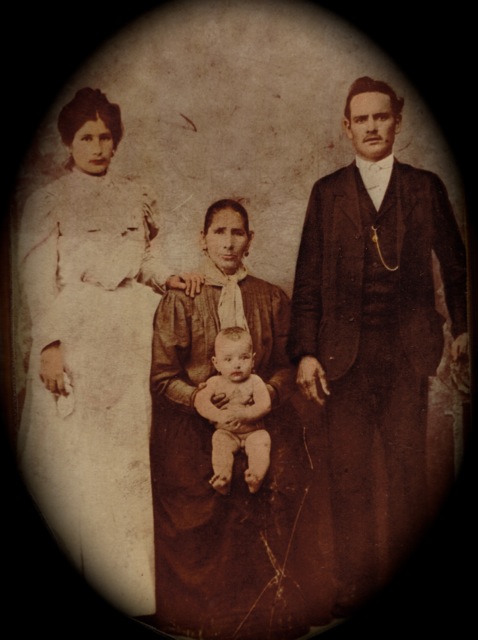
Grandparents Domenica Iacovone and Giuseppe della Croce, great-grandmother Laura Iacovone with my father, infant Giovanni, after arriving in New York City, 1909.
My father left his native Toritto as an infant in his mother’s arms in 1909. With his young parents and grandmother, he sailed for Ellis Island in steerage. The family said that in those bleak times in Puglia, they had survived by eating the wild greens that grew in the fields where they had toiled. Although he returned to Italy many times as an adult, especially to the Carrara quarries to buy marble for his shop in America, my father never went back to where he was born. What kindled his memory was the food he was raised on. His favorite was pasta with beans or chick-peas. He insisted that my mother cook the bitter greens—cicoria (dandelion greens) and cime di rapa (broccoli rabe)—which the emigrants grew in their gardens or occasionally managed to find in Italian markets.
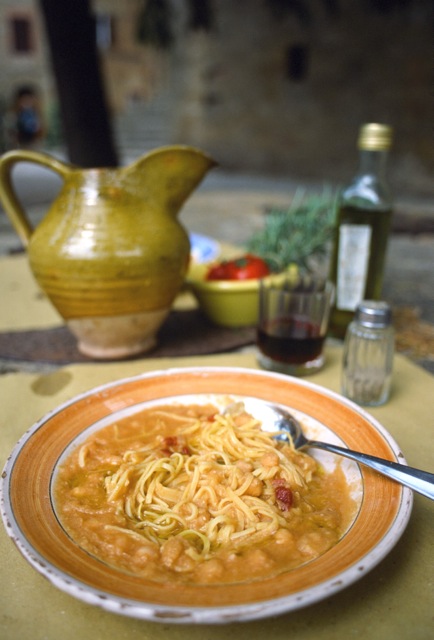
Pasta e ceci, a dish of the cucina povera. | Photo by Paolo Destefanis for Roma: Recipes From in and Around the Eternal City, by Julia della Croce
Despite a lifetime of traveling Italy’s far corners and byways, something has also kept me away. Last month, some six years after my father’s passing at nearly 100, I decided it was time for me to feel Toritto’s dirt under my feet.
I made a stop in what seemed like a desolate town and then headed for the countryside where I knew my family of poor sharecroppers was bound to have lived.
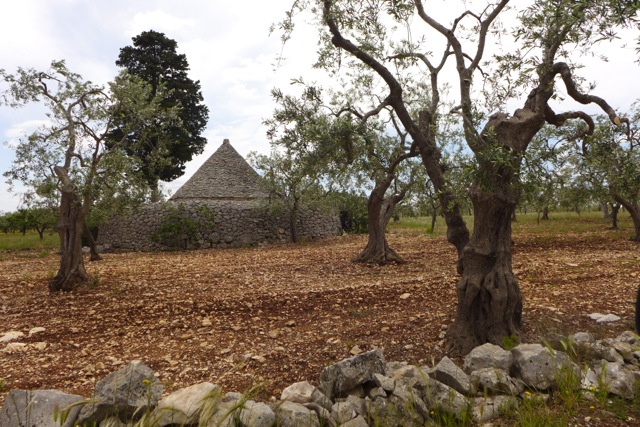
In the nearby countryside, a trullo, a traditional peasant hut with a conical roof. | Photo: Nathan Hoyt
Following a dirt road out of town into what seemed like a maze of endless olive groves, I saw a lone man tending a garden and stopped to talk to him.
His face read familiar, and his vernacular, too. His house, a simple tower without running water or power, made of stone retrieved from a nearby ruin, was surrounded by cherry, almond, and olive trees, artichoke fields in bloom, vegetable patches, and fields of the cicoria and cime di rapa that my father adored.
He invited us in to the tower, a work in progress—there was no roof yet; the garden is where he really lives.
I ate fistfuls of cherries and mulberries, roasted almonds that we smashed with stones to open, accepted bouquets of artichokes, and was soon, too soon, on my way.
Antonio Bartolomeo is the gardener’s name and he sends me messages from my father’s land now and then, like this one, in time for Father’s Day. Have a happy one.


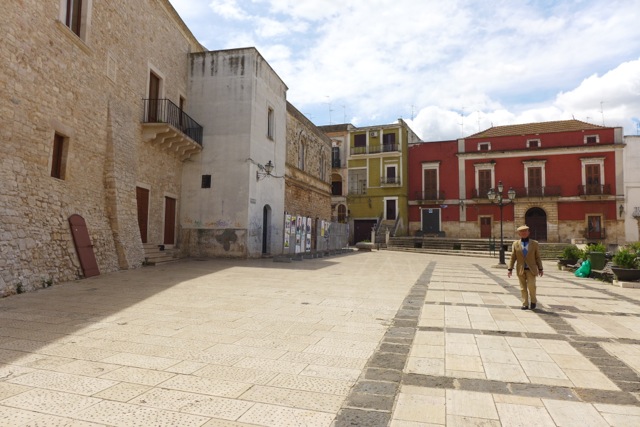
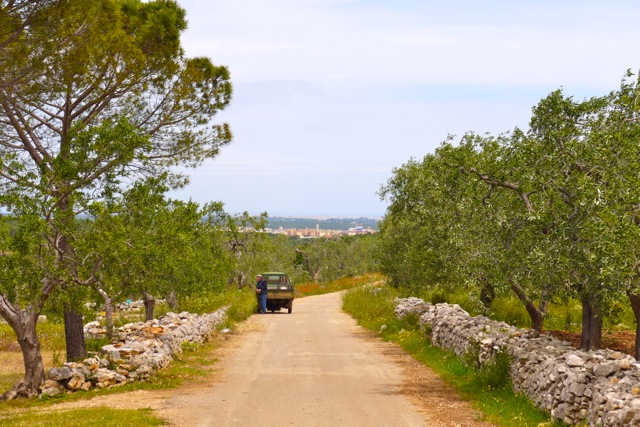

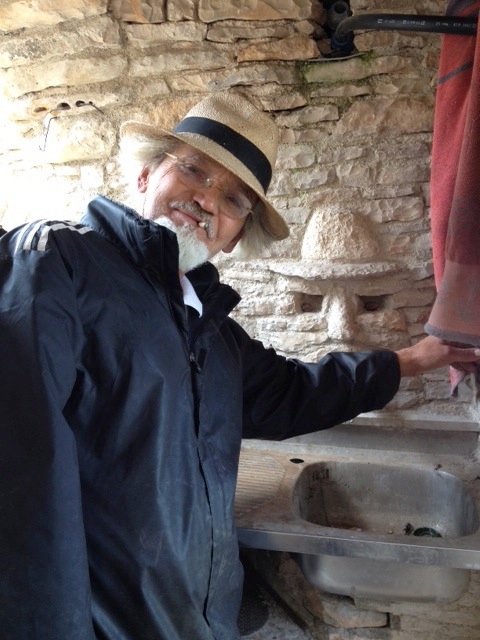
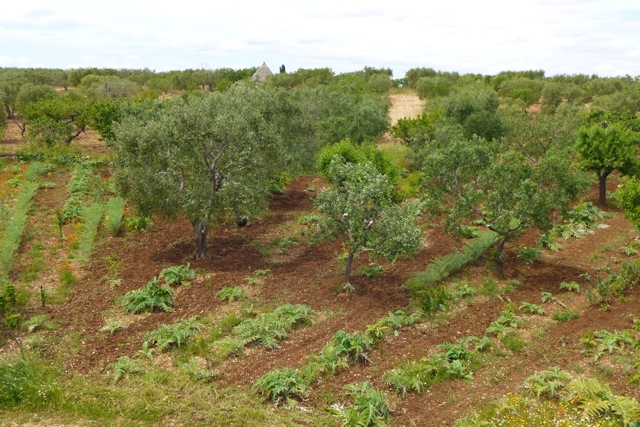
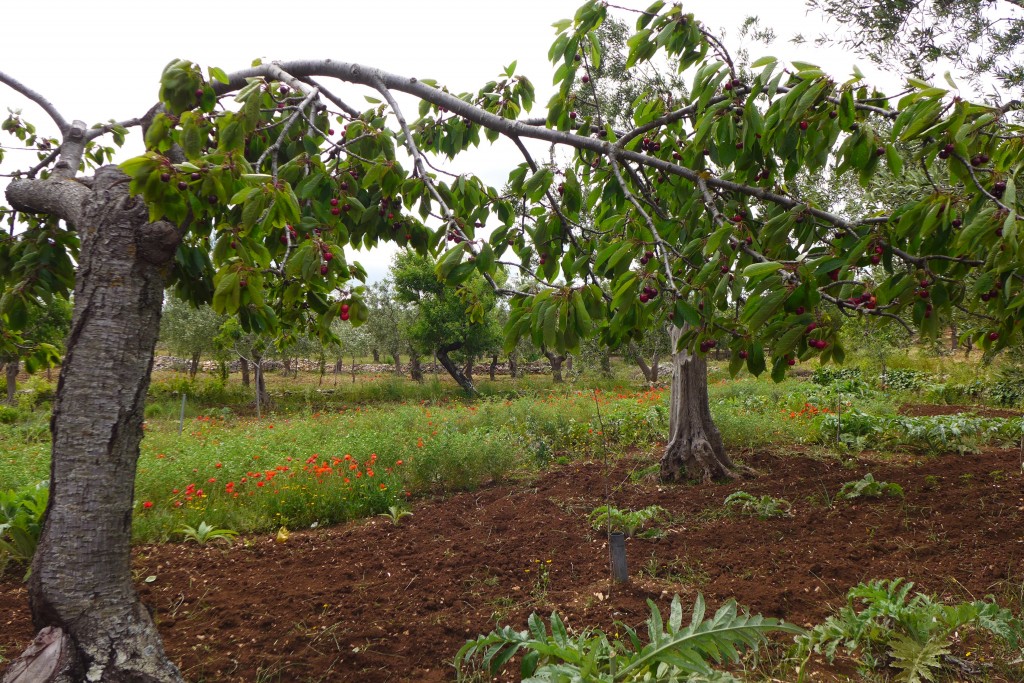
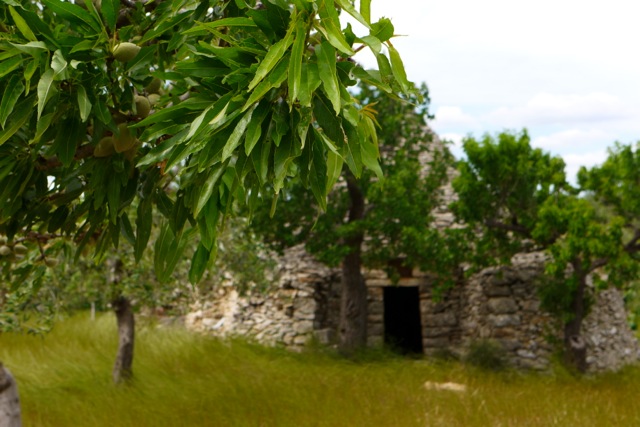
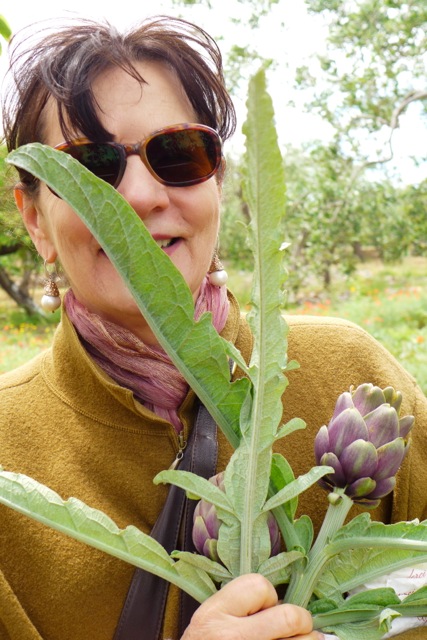
 Follow
Follow
 email
email
“A self-portrait in stone;” “the garden is where he really lives;” I feel your father’s life and loves in this visit with Mr. Bartolomeo, who sends you so much more than messages from your father’s land. Welcome home, dear Julia.
It’s true, Barbara. It was and is so much more.
Wonderful tribute. Happy that you took your eyes and your feet and heart and your taste-buds to Italy. It’s great to see feet and faces that look familiar. Plus,I think it makes our personal circle complete.
You look so happy Julia! Maybe Torrito will call you back more often…such a lovely story!
Very sweet story, Mama. I am sorry that I was so close and yet missed the trip.
Next time, Gabriella.
This is an amazing story, so happy you managed to visit your father’s town. Fantastic tribute!
Grazie! A few new photos added that I realized I had left out.
Very touching article Julia, we loved it! A journey into your memories, with the traditional flavours of Puglia as background. Cicorie e cime di rapa are definitely a must 🙂
Naturally! Thanks for your comments.
Julia, what a wonderful and inspired journey! Brava to you for revisiting your oh-so-interesting past.
Maybe you’ll make your own journey like that some day, Linda.
Julia, that was a great story. I found it especially touching since I knew your father for so many years. I also had to smile when you talked about the dandelion because I remember your mom making the most wonderful dandelion soup when we were kids. I never forgot that!! Thank you for the mini vacation. I almost felt like I was there with you. Eugenia
Oh, how I wish you could remember the soup because somehow, I don’t! She cooked so many things, she was such a good cook. Everything she made was wonderful.
foto bellissime. La Puglia e’ un’incanto e cosi anche il suo cibo!
Vero, Anna Maria!
Una bella storia ed una bella esperienza immagino. Con la speranza che possa ritornare nel nostro amato paese. Saluti..
Grazie!
I read the story with much interest and familiarity. My grandfather (Matteo Mongelli) was from Toritto , the eldest son, was sent to America at age 16 in 1922 to support his family in Italy. He too, was from the poor farming community of olives and almonds. Unfortunately, he never had the opportunity to return to Italy and never saw his parents again after he left Toritto. I reflect on this often and realize what a very different world it was, near 100 years ago. He settled in the Bronx where he was initially an iceman, from what I understand a common occupation of Barize men. He married Clara Pecora, an immigrant from Sicily, had two daughters, Kathleen (my mother) and Mary Susan, They found many of the home foods and traditions visiting Arthur Avenue, for the food and customs, without the tourism. Until his death in 1978 he always sent money back to his native land, to his remaining brothers and sisters. He had helped 2 of his sisters come to the US, which did travel back to Italy. He made a modest but hard living, opening up a moving business which he operated under my grandmothers name, as his written English was not strong and he never became a US citizen. Although, he was a strong US patriot, always standing during the national anthem on the TV, prior to the NY Yankee games.
In 1986, after college, I took a 3 month backpack trip through Europe. One of my stops was to find the small village of Toritto. At that time, many of his brothers and sisters were still alive and upon learning who I was (with a photo of my grandfather and myself from earlier years), the relatives fought over where I would eat and sleep each night, somewhat paying tribute to my grandfather. It was a wonderful experience and a cherished memory. This Summer, I plan to travel back to Toritto with my family who have heard these stories countless times. His name was Matteo, but when he came to America, they americanized the name and called him Marty. My mother named me Martin. Very proud of the Toritto, Italy heritage and how an immigrant took a risk to better his family, unselfishly.
Dear Martin,
I don’t know how I missed the comment you left way back in February, but I was delighted to read it. Your experience is very familiar to me and I can easily imagine how precious your presence was to your long lost family in Toritto. I spent a good part of 2018 researching the histories of Italy’s regions, including that of Puglia, for the atlas section of a book published by National Geographic in October titled “Tasting Italy.” While I had heard something about the struggles of agricultural workers in that part of Italy and particularly in the Bari province in the last century from my father and grandparents (they emigrated to NY in 1908), the research I did lead me to details about the shocking abuse of the “latifundia,” tenant-farmer system that was in place at that time. A particular study done by a Cambridge academic of Toritto in the early part of the 20th century was a wealth of information accompanied by references to source material that could lead one to further reading. If you are interested, let me know and I will tell you the title and author (I was able to find it on the internet). I am so pleased to hear your story, thanks so much for writing to me. Warmest, Julia
hello julia my family is also from toritto my great grandfather came in the early 1890s and again in 98. my wife and i explored the region 2 yrs ago and i loved it and found your story when serching for more olive oil from toritto. i looked back in my family tree and as it turns out my great grandfather, antonio simonettis great grandmothers name was Felicia Iacavone were i found she died before 1827 and was married to Francesco Morea. cant wait until we visit again
thank you jerry and karen simonetti
So interesting, Jerry. After reading your message, I went back to my family documents and found this: My grandmother’s name was Domenica Iacovone (literally, “son of Jacob,” in English, “Jacobson”). She was born in 1887 and emigrated to New York (Ellis Island) with my grandfather, Giuseppe Dellacroce from Grumo (nearby town) in 1908. Her father’s name was Domenico Iacovone; her mother’s (in the photo above) was Laura Morea. It appears there are some family connections here. Did you learn anything more about your ancestors from Toritto when you spent time there or since? I’m wondering if you were able to connect with anyone there you are related to?
Julia, I am writing this as i am truly overwhelmed by what i am reading. My grandmother Anna Morea also was from Toritto Bari. She was an unbelievable woman. Loved by her family. Anna taught us how to appreciate life and be grateful for all that we have no matter how great or how small. We were blessed to have this talented woman in our lives. She was a seamstress that made so many items for her family. She crocheted blankets that each family received and still has. Anna lived 95 years on this earth but will live in the hearts of us all forever.
She had 5 children, 15 grandchildren, 31 greatgrandchildren and several great great grandchildren
Our youngest is named Ava Morea Kelly in her honor
I am overwhelmed by all that I am reading. My grandmother Anna(Morea) also came from Toritto. She was very loved here by her children, grandchildren and great grandchildren. My little granddaughter was named Ava Morea Kelly in honor of this unbelievable loving woman. Grandma too never had the opportunity to see her parents again after leaving Italyin the early 1900’s as she returned many years later when she was in her fifties. She graced us with many stories but most importantly she taught us how to appreciate and be grateful for all we had. She was a seamstress that made our communion dresses and many memorable items. All of my children went to college with a blanket crocheted by her and to this day we still all have these blankets. She lived on this earth until 95 but lives in our hearts forever.
Hello Jerry and apologies for the delay in answering. I’m very happy that you were so moved by the post. You might be interested to know that my paternal grandmother’s name at birth was Laura Morea and she was also born in Puglia, either Toritto or Grumo; at the moment, I don’t recall which, though I could look it up. It is certainly possible that we are related. She emigrated to New York City in 1908 with her daughter and her daughter’s husband, my grandfather Giuseppe Della Croce. They were impoverished tenant farmers in the Bari region. They settled in the Bronx, where my father, Giovanni Della Croce, grew up. How lovely to have those memories of your grandmother.
Hi Julia. My name is Fred Salerno. My maternal grandparents Guiseppi Simonetti and Maria Mongelli arrived in New York around 1904. They weren’t married at the time but soon after married and had seven children. I am currently put together a family that has over 900 entries. Along with that is an accompanying history. I would be very muck appreciative if you could share the research articles from Cambridge. Thank you! Fred
BTW for others in this chain we have Moreas in the tree
Hello Fred, Apologies for not answering sooner. I have been off my blog for two years, but coming back.I don’t understand your question? Hope to hear from you again.
I am so happy to learn of my husband’s, Joseph Dellacroce, lineage. He was the son of Leo Dellacroce and John, your father, was his Uncle. I have tried to do a family tree on the Dellacroce side for my children but have not had much luck with past descendents. Obviously these notes help me to connect the past.
I am an avid collector of your books which also reveal stories about your family mingled in with wonderful recipes. I even had signed up for a class that you were teaching a few years back but unfortunately was cancelled due to illness. I hope that this note finds you well and I would be happy to attend a future class if you are teaching in the area….Connecticut!
Hello Kelly! I’m so sorryI didn’t see your message sooner. I’ve been away from my blog for some two years. Yes, I was very ill and my husband was as well, at the same time. He died two years ago and I haven’t had the mind to continue writing until now. I’m back, and now working on another book, a memoire-novel.It really is lovely to hear from you. I’ve moved to MA to be with my two daughters, who live near me now. I’d love to hear from you again. You can always contact me by email: julia@juliadellacroce.com.